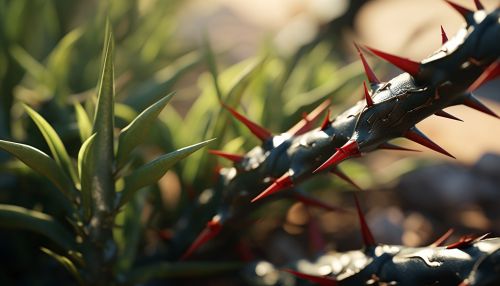Mechanisms of Plant Defense Against Insect Herbivores
Introduction
Plants, as stationary organisms, have evolved a variety of defense mechanisms to protect themselves from herbivorous insects. These mechanisms can be broadly classified into two categories: constitutive defenses, which are always present in the plant, and induced defenses, which are activated in response to insect attack.
Constitutive Defenses
Constitutive defenses are the plant's first line of defense against insect herbivores. These include physical barriers such as thorns and tough leaves, as well as chemical defenses like toxic or repellent compounds.
Physical Barriers


Physical barriers are structural features of the plant that deter herbivores. These can include thorns, spines, and prickles, which can physically harm the insect, or tough, leathery leaves and stems that are difficult for insects to chew through. Some plants also have trichomes, hair-like structures on the leaf surface that can entangle and trap small insects.
Chemical Defenses
Chemical defenses involve the production of compounds that are toxic or repellent to insects. These can include secondary metabolites such as alkaloids, terpenoids, and phenolics. Some plants also produce compounds that interfere with the insect's digestion or reproduction.
Induced Defenses
Induced defenses are activated in response to insect attack. These can include changes in the plant's chemistry, such as the production of additional defensive compounds, or changes in the plant's physiology, such as the closing of stomata.
Chemical Changes
In response to insect attack, plants can increase the production of defensive compounds. For example, some plants produce compounds that attract the natural enemies of the attacking insect, a strategy known as indirect defense. Other plants produce compounds that interfere with the insect's ability to digest the plant material, reducing the nutritional value of the plant for the insect.
Physiological Changes
Physiological changes can also play a role in plant defense. For example, some plants close their stomata (the pores through which they exchange gases with the environment) in response to insect attack, reducing the insect's access to the plant's interior. Other plants increase the toughness of their leaves or stems, making them more difficult for the insects to chew through.
Co-evolution of Plants and Insects
The defenses of plants and the counter-defenses of insects have co-evolved over millions of years, leading to a complex and dynamic relationship between plants and their insect herbivores. This co-evolutionary arms race has driven the diversification and specialization of both plants and insects, and continues to shape their interactions today.
Conclusion
Understanding the mechanisms of plant defense against insect herbivores is crucial for developing sustainable agricultural practices and for conserving biodiversity. By studying these defenses, scientists can gain insights into the complex interactions between plants and insects, and can develop strategies to protect crops from insect pests while minimizing the use of harmful pesticides.
